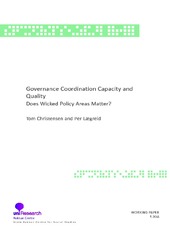| dc.description.abstract | Based on a study of civil servants in the Norwegian central government, this article describes perceptions of coordination quality along the vertical/horizontal and internal/external dimensions as well as overall perceived coordination capacity. Second, it examines to what degree the variations in perceived coordination quality and coordinating capacity can be explained by structural and cultural features. In particular it focuses on the significance of wpicked policy areas. The data base is a survey of civil servants in Norwegian ministries and central agencies conducted in 2016. A main finding is a complex picture concerning the importance of wicked policy area, with similarity in coordination perception patterns, but also variety among the three wicked areas of climate change, immigration and police. The overall variation in perceptions of coordination capacity and quality is primarily related to cultural factors, such as mutual trust, level of conflict and identification with central government. But some structural features, such as administrative level, also have an effect. | en_US |
